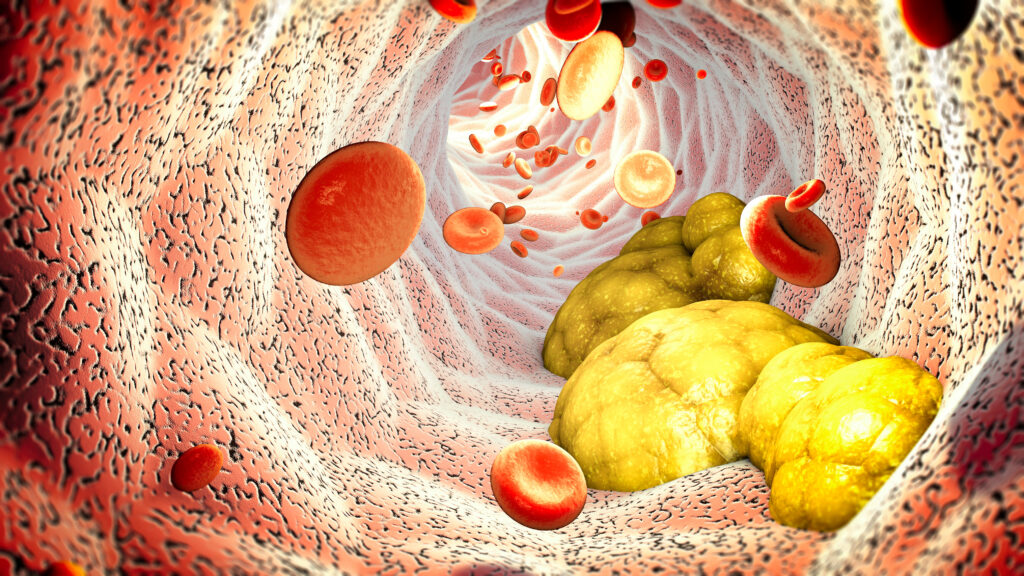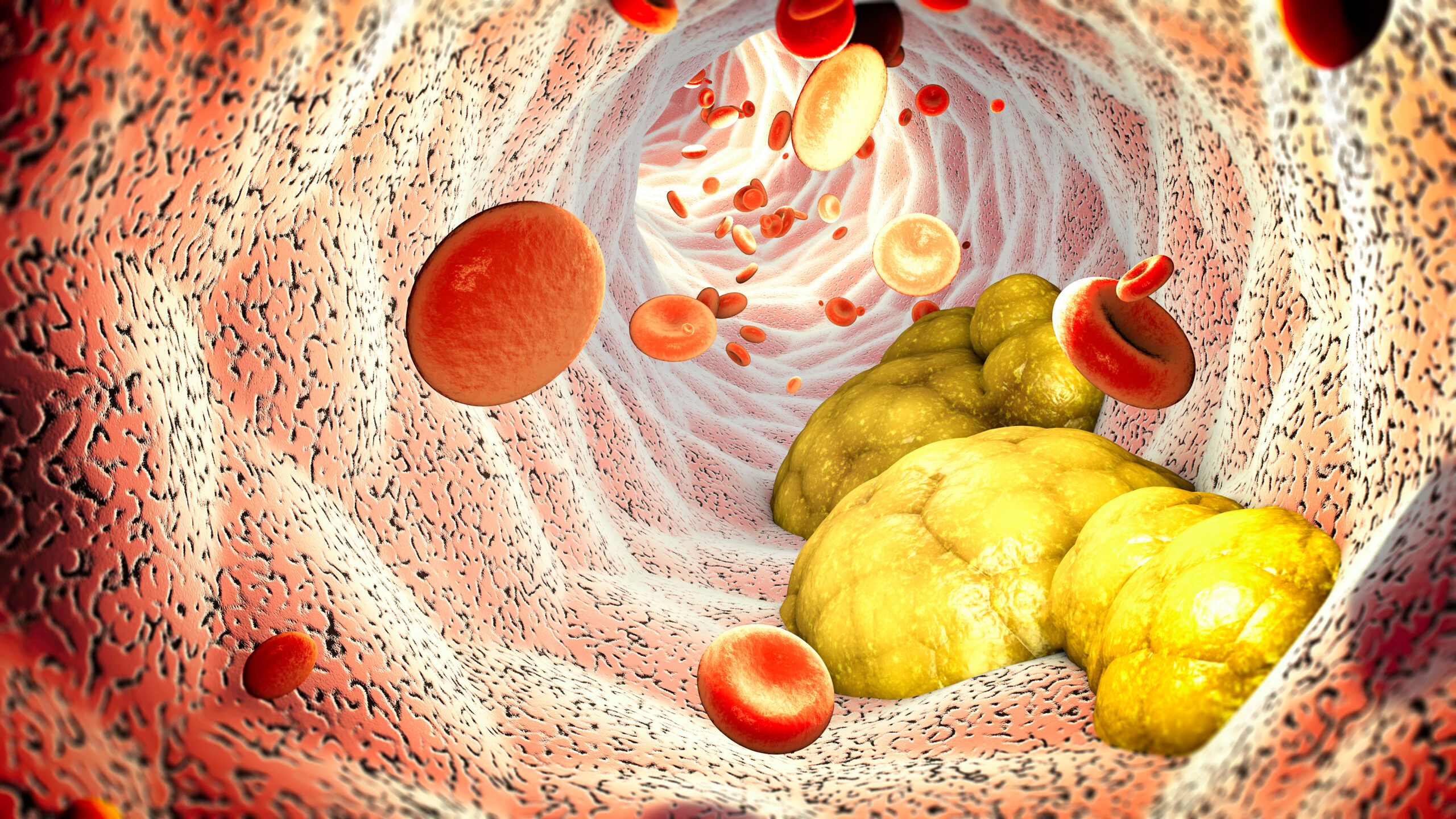It can be alarming to learn you have high triglycerides. As your triglyceride number climbs, so does your risk of cardiovascular disease. Your doctor may suggest losing weight, exercising more, changing your diet, or starting new medications. Of all the changes you may have to make, optimizing nutrition should be your first priority.
Recently, a client was referred to me with an extremely high triglyceride level. This client was diagnosed with familial hypertriglyceridemia or high triglycerides in part due to genetics. Several months of taking multiple lipid-lowering medications proved ineffective, so his cardiologist asked me to help him adjust his diet to lower triglycerides.
I created a personalized eating plan with the goal of decreasing inflammation, improving insulin resistance, reducing the amount of saturated fat in his diet, and increasing his intake of soluble fiber and omega-3 fatty acids. After three months of following my plan, this client’s triglycerides went from a whopping 1311 mg/dL to 229 mg/dL with no other changes to lifestyle or medication.
The moral of the story is that medications have their place, but nutrition is essential to lower triglycerides. Eating the right foods in the right doses, while reducing your intake of foods that drive triglycerides up is foundational to blood and heart health.
Wondering how to successfully improve your triglycerides? These are the key areas to address:
- How diet influences triglyceride levels
- Which foods and nutrients raise triglycerides and which lower them
- A list of the best foods to lower triglycerides
Triglycerides and Your Health

Triglycerides are a type of fat, or lipid, found in your blood. Lab work can assess your triglyceride levels and tell you where they fall on the following scale:
- Optimal: Less than 100 mg/dL
- Normal: Less than 150 mg/dL
- Borderline high: 150 to 199 mg/dL
- High: 200 to 499 mg/dL
- Very high: Above 500 mg/dL
There are three main factors that contribute to elevated triglycerides:
- Eating too many calories
Your body naturally produces triglycerides to store extra energy from food (i.e. calories) that it can’t use right away. Triglycerides are stored in fat cells and released when you need energy. Eating more calories than your body can use day after day can raise triglycerides to unhealthy levels.
- High intake of unhealthy fats
Dietary fats, including butter, oils, and foods high in saturated or trans fats, are another source of triglycerides. Eating too many of these foods can also contribute to high triglycerides.
- Genetics
Some people have genetic disorders that change how their body manufactures and breaks down fats, resulting in higher than normal triglycerides.
There’s ample evidence that elevated triglycerides are a strong independent risk factor for heart disease. High triglycerides contribute to:
- Arteriosclerosis, or hardened and thickened arteries
- Thickened blood, which increases the risk of blood clots and interferes with proper blood flow
- Increased risk of heart attack and stroke due to the above factors. Ischemic strokes, in particular, have been linked to high triglycerides. They’re caused when a blood clot restricts blood flow in the brain. The arterial plaque buildup that occurs with arteriosclerosis contributes to the development of blood clots.
- Pancreatitis, or an inflamed pancreas, is a painful condition that causes abdominal pain, nausea, and vomiting. Researchers suspect high triglycerides interrupt normal blood flow to the pancreas, which injures the organ and disrupts functioning.
The good news is triglycerides are a modifiable risk factor. If your triglycerides are elevated, you can follow a heart healthy diet to lower triglycerides.
Using Diet to Lower Triglycerides
Excess inflammation in your body and poor blood sugar control can change how your body metabolizes fats. Foods that trigger inflammation and spike blood sugar levels can also raise triglycerides.
Foods and ingredients that raise triglycerides include:
- Alcohol
- Refined carbohydrates, like white bread and pretzels
- Saturated fats found in butter, red meat, packaged snacks, and baked goods
- Refined Sugar
- Trans fats found in processed foods that contain partially hydrogenated oils
Decreasing your intake of these foods while increasing your intake of omega-3 fatty acids and soluble fiber effectively lower triglycerides.
Omega-3 fatty acids help decrease inflammation and inhibit the production of triglycerides in the liver. Researchers have also observed decreased fat absorption in the intestine following omega-3 supplementation.
Soluble fiber helps slow the digestion of food in your intestines, which can decrease the amount of fat and sugar you absorb from food resulting in lower triglycerides and more stable blood sugar levels.
The 10 Best Foods to Lower Triglycerides
Here are the best triglyceride lowering foods.
- Salmon
Salmon is a good source of omega-3 fatty acids. Studies have found eating fatty fish like salmon several times a week successfully reduces triglycerides, as well as lowers LDL cholesterol and increases HDL cholesterol. Other omega-3 rich fatty fish to try include sardines, rainbow trout, herring, mackerel, and sardines.
- Avocado
Avocados are a good source of both soluble fiber and monounsaturated fats, both of which can improve triglyceride numbers. Swapping a serving of avocado for carbohydrates and/or saturated fat has been found to lower triglycerides.
Try mashed avocado with veggies, spread on whole grain toast with heart healthy lean protein, or add sliced avocado to salads.
- Lentils
Lentils are a fiber-rich food. Just half a cup of cooked lentils contains 8 grams of fiber, which can help slow digestion and absorption of sugar and fat from your meals. Without adequate fiber, absorption of sugar and fat occurs more rapidly and high intakes of these nutrients contribute to high triglycerides. Swap lentils for pasta in soup, add to salads, or cook with veggies and herbs for a savory side dish.
- Blueberries
Blueberries, as well as strawberries, raspberries, and blackberries, are low-sugar fruits. They’re good sources of fiber and antioxidants, which also play an important role in regulating inflammation. Researchers also credit phytochemicals in berries and other plant foods with supporting normal lipid metabolism to promote healthy triglyceride levels.
- Broccoli
Broccoli and other cruciferous vegetables, like cabbage, kale, and cauliflower, contain fiber and compounds called glucosinolates, which possess antioxidant and anti-inflammatory properties. Systemic inflammation is linked to increased triglycerides, so eating more antioxidant-rich foods can help regulate inflammation and support triglyceride levels.
- Oats
Consumption of whole grains, like oats, in place of refined carbohydrates is associated with reductions in triglycerides. Oats and other whole grains are good sources of soluble fiber, which slows digestive transit time and can lower the amount of sugar and fat you absorb from food.
- Olive oil
Olive oil is a healthy oil full of monounsaturated fat. Studies have found replacing carbohydrates and/or saturated fat with monounsaturated fat can lower triglycerides. Use it to replace butter, coconut oil, and other saturated fats, ideally off the heat.
- Spinach
Like berries and cruciferous vegetables, spinach contains antioxidants and phytochemicals that regulate inflammation and support heart health. One such compound is alpha lipoic acid, which has been found to benefit triglyceride levels.
- Tofu
Tofu and other soy products, like edamame and tempeh, are considered a triglyceride lowering food thanks to their isoflavone content. Isoflavones are a type of phytochemical with antioxidant and anti-inflammatory properties that support normal lipid metabolism.
- Walnuts
Walnuts contain fiber and antioxidants and are a good source of unsaturated fats, including omega-3 fatty acids. Studies have found regular walnut consumption is associated with lower levels of triglycerides.
Takeaway
Knowing your triglyceride number is an essential part of caring for your heart. If your triglycerides are high, taking steps to help bring them down can help lower your risk of cardiovascular disease.
Alcohol, refined carbohydrates, sweets, and foods that contain excess saturated or trans fat can increase triglycerides. Fiber-rich foods and sources of healthy, unsaturated fats or omega-3 fats are proven to improve triglyceride levels and reduce the risk of cardiovascular disease.
However, it may not be enough to just add triglyceride lowering foods into your diet. Optimizing your food intake for your individualized needs is the key to success.
A cardiovascular dietitian can help you pinpoint which diet and lifestyle factors may be driving your triglycerides up and work with you to create a plan that includes more triglyceride lowering foods in therapeutic doses tailored to your unique needs.
If you’re ready to improve your nutrition with personalized science, lower triglyceride numbers, and reduce your risk of heart disease, I’m here to help. Use this link to schedule a free 15-minute discovery call to discuss further.
References
1. Karanchi H, Muppidi V, Wyne K. Hypertriglyceridemia. [Updated 2023 Feb 12]. In: StatPearls [Internet]. Treasure Island (FL): StatPearls Publishing; 2023 Jan-. Available from: https://www.ncbi.nlm.nih.gov/books/NBK459368/
2. Garg R, Rustagi T. Management of Hypertriglyceridemia Induced Acute Pancreatitis. Biomed Res Int. 2018;2018:4721357. Published 2018 Jul 26. Available from: https://www.ncbi.nlm.nih.gov/pmc/articles/PMC6083537/
3. Feingold KR, Grunfeld C. The Effect of Inflammation and Infection on Lipids and Lipoproteins. [Updated 2022 Mar 7]. In: Feingold KR, Anawalt B, Blackman MR, et al., editors. Endotext [Internet]. South Dartmouth (MA): MDText.com, Inc.; 2000-. Available from: https://www.ncbi.nlm.nih.gov/books/NBK326741/
4. Parhofer KG. Interaction between Glucose and Lipid Metabolism: More than Diabetic Dyslipidemia. Diabetes Metab J. 2015;39(5):353-362. doi:10.4093/dmj.2015.39.5.353
5. Bornfeldt KE. Triglyceride lowering by omega-3 fatty acids: a mechanism mediated by N-acyl taurines. J Clin Invest. 2021;131(6):e147558. doi:10.1172/JCI147558
6. Amigó N, Akinkuolie AO, Chiuve SE, Correig X, Cook NR, Mora S. Habitual Fish Consumption, n-3 Fatty Acids, and Nuclear Magnetic Resonance Lipoprotein Subfractions in Women. J Am Heart Assoc. 2020;9(5):e014963. doi:10.1161/JAHA.119.014963
7. Park E, Edirisinghe I, Burton-Freeman B. Avocado Fruit on Postprandial Markers of Cardio-Metabolic Risk: A Randomized Controlled Dose Response Trial in Overweight and Obese Men and Women. Nutrients. 2018;10(9):1287. Published 2018 Sep 12. doi:10.3390/nu10091287
8. Basu A. Role of Berry Bioactive Compounds on Lipids and Lipoproteins in Diabetes and Metabolic Syndrome. Nutrients. 2019;11(9):1983. Published 2019 Aug 22. doi:10.3390/nu11091983
9. Connolly EL, Sim M, Travica N, et al. Glucosinolates From Cruciferous Vegetables and Their Potential Role in Chronic Disease: Investigating the Preclinical and Clinical Evidence. Front Pharmacol. 2021;12:767975. Published 2021 Oct 26. doi:10.3389/fphar.2021.767975
10. Hollænder PL, Ross AB, Kristensen M. Whole-grain and blood lipid changes in apparently healthy adults: a systematic review and meta-analysis of randomized controlled studies. Am J Clin Nutr. 2015;102(3):556-572. doi:10.3945/ajcn.115.109165
11. Forouhi NG, Krauss RM, Taubes G, Willett W. Dietary fat and cardiometabolic health: evidence, controversies, and consensus for guidance. BMJ. 2018;361:k2139. Published 2018 Jun 13. doi:10.1136/bmj.k2139
12. Haghighatdoost F, Hariri M. Does alpha-lipoic acid affect lipid profile? A meta-analysis and systematic review on randomized controlled trials. Eur J Pharmacol. 2019;847:1-10. doi:10.1016/j.ejphar.2019.01.001
13. Ramdath DD, Padhi EM, Sarfaraz S, Renwick S, Duncan AM. Beyond the Cholesterol-Lowering Effect of Soy Protein: A Review of the Effects of Dietary Soy and Its Constituents on Risk Factors for Cardiovascular Disease. Nutrients. 2017;9(4):324. Published 2017 Mar 24. doi:10.3390/nu9040324
14. Guasch-Ferré M, Li J, Hu FB, Salas-Salvadó J, Tobias DK. Effects of walnut consumption on blood lipids and other cardiovascular risk factors: an updated meta-analysis and systematic review of controlled trials. Am J Clin Nutr. 2018;108(1):174-187. doi:10.1093/ajcn/nqy091
